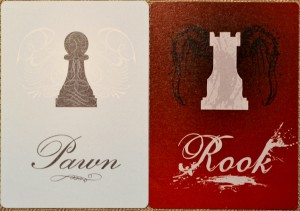As a former professional “Chess” player, I had thought that I had seen everything. First it was “For the Crown“, an oddly satisfying deck-building “Chess” game, and now this. While cards are again involved in this particular “Chess” variant, they actually become the pieces in which players will be strategically placing and moving around. No worries fellow “Chess” players, the object of the game is still the same: capture the enemy King through checkmate. How this is accomplished however bears a little explanation. Before we touch on specifics, I’d like to quickly thank the folks at Victory Point Games for providing me with a free press copy.
Components
Cards – The game comes with a total of fifty cards, which are broken up into twenty-four red cards, twenty-four blue cards, and two player aid cards.
While not an actual component, there will be an imaginary 3 (wide) x 6 (long) card grid between both players. This is referred to as the “Arena”.
Setup & Gameplay
Each player gets a deck of cards of a particular color, removes the King, and places it in front of them face up. They’ll then shuffle their own respective decks and place them off to the side. Each player draws four cards and randomly places them facedown around their King. One card will go on the King’s left, one card will go on the King’s right, and two will go in front of him. In essence, each player will be forming an upside-down “T”, based on their point of view. Finally, each player draws three cards to form their hand with red going first.
Like “Chess”, each piece in the game has its own way of moving. Unlike “Chess”, movement rules can vary slightly and there’s even a new Prince “piece”. This is in addition to your standard King, Queen, Rook, Bishop, Knight, and Pawn pieces. I won’t go into each piece’s movement behavior in detail, but suffice it to say that they mimic the original movement rules almost exactly with only few notable exceptions. The Prince piece, for those of you who are curious, moves like the King but can be captured without ending the game. It’s also worth noting that there is no castling and there is no en passant (as the pawns do not observe the option to move two spaces on their first move).
Each player performs a set of actions on their turn, which can be summarized as follows:
1) The current player must flip a face-down card on the arena face-up.
2) The current player must move a face-up card. Landing on an enemy card captures it.
3) The current player will announce “check”, if applicable. It is possible to capture the enemy King via steps one and two without a “check” ever taking place.
4) The current player will play a card from their hand face-down onto their side of the arena. If their side of the arena is full, they can replace a card, discarding it. Alternatively, they can discard a card from their hand.
5) The current player will draw a card from their deck, placing it into their hand.
The first player to checkmate the enemy King, wins the game!
While the above doesn’t cover all if the rules found in the manual, it should give you a general idea on how the game is played. For more information, please refer to the rules located here:
http://victorypointgames.com/documents/KingsRansom_Rules_v1.10.pdf
The Review
Right off the bat, I can tell you that I was impressed with the packaging and the way the game was presented. The plastic clamshell cover that the game comes in pops open and closes shut easily, allowing it to be re-used without any trouble. After getting the cover off, I noticed a topless and bottomless card box from which the cards slid out of, though they were held together by a brown paper strip. I would have prefered a standard card case, just so that I can put the deck in my pocket and take it with me without fear of the cards sliding out. The instructions serve as the back piece inside the plastic case and can be removed, unfolded, and refolded at will in order to put the game back to its original state.
The card art itself bears a rather lengthy round of applause. The overall art style is that of pure elegance, coupled with an odd light blue/dark red pairing that somehow remains to look amazing. The contrasting colors serve each other well, in my opinion. Everything from the cursive writing to the pictures on the faces were superbly done. The feel of the cards were equally good, though it’s possible to bend them if you aren’t careful. The same can be said for the box, which unfortunately ripped on me the second time I attempted to put the cards away. The manual was well-organized and very easy to read. I particularly liked the FAQ section at the end, which helped to address the oddball occurrences that might come up for experienced “Chess” players.
The gameplay itself was easy to understand, though I admit that I’m sort of biased in that regard. I’ve been playing “Chess” (professionally and not) for over twenty years, so the moves came easily to me and there was really no learning curve of which to speak. Those completely new to “Chess” may need to go through a bit of training, but not in the way a normal “Chess” player would. For one, there’s no standard 8×8 board. The grid in “King’s Ransom” is much smaller, limiting the moves available to a player. To veterans in the field, this limitation can actually serve to be a nuisance. To new players however, this can actually serve to help them learn standard “Chess” without that strategic handicap.
Along those same lines, “King’s Ransom” is a bit luck-based unlike its original counterpart. In “Chess”, you have your entire army at your disposal from the get go. Here, you’re limited by the cards you draw. With that being said, this addition of a luck-based characteristic actually served to stretch my mind a little in ways that “Chess” never did. I had to learn to make do with what I had, rather than assume that a particular piece would be available should I need it. While being a “Chess” variant, it certainly plays a lot differently than what I had expected. There’s also the fact that castling and other special moves are not supported, though I don’t see why folks couldn’t experiment with their own house rules if they so chose.
In the end, “King’s Ransom” is an astoundingly unique idea that deserves your attention. Grandmasters and newcomers alike will find something to love about the game and may even serve as a learning tool for the latter. The recommended age might be a bit on the high side, considering that “Chess” can be learned at almost any age…I personally taught my brother when he was only six years old. As such, gifted children who are already familiar with “Chess” should have no issues with this game. When you step back and take a look at the big picture, “King’s Ransom” is both pretty in appearance and fun to play…the hallmark of a superb game. Coupled with the fact that the game is only $10.99 (as of 11/15/13), I am forced to arrive at one unescapable conclusion…”King’s Ransom” is a must-buy. My only gripe is the flimsy box in which it came…not only did I wish it to be more durable, but top and bottom covers would have gone a long way to make it travel friendly. Despite this minor kerfuffle, I’d easily recommend this game to anyone who enjoys thinking a bit in the games they play.
Final Verdict: 9/10
—
You can learn more about and purchase “King’s Ransom” by visiting the following websites:
http://victorypointgames.com/details.php?prodId=249
—


